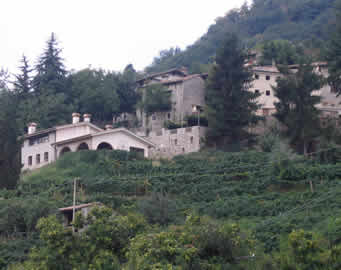Prosecco is easily Italy’s most popular sparkling wine.
Light, refreshingly effervescent and inexpensive, it is an integral part of most luncheons, weddings, birthday parties and other celebrations throughout Italy. It is also a popular before-dinner drink (aperitivo), not only in the Veneto region in northeastern Italy – which is Prosecco’s traditional home – but throughout the length and width of the country.
All Prosecco wines are made primarily or exclusively from the Prosecco grape (now officially known as Glera – but more on this later) which must account for at least 85 percent of the final blend. The remaining 15 percent can consist of other locally grown white varietals.
These white wines can be lightly sparkling (frizzante) or fully sparkling (spumante). However, Prosecco wines can also vary based on the amount of residual sugar in the wine. While Prosecco is not a sweet wine, there are four basic categories to indicate the amount of residual sugar in the wine and, hence, the degree of “dryness” or conversely “sweetness” of the wine. Moving from driest to the sweetest is Brut, Extra Dry, Dry and Demi-Sec. Counter-intuitively, “Dry” Prosecco is a touch sweeter than the “Extra Dry” and “Extra Dry” is a skosh sweeter than “Brut.”
In 2009, the Italian authorities implemented some significant changes designed to boost quality as well as protect the territorial integrity of the Prosecco name. First, the Conegliano-Valdobbiadene (co neyl yah’ no – val doh bee ah’ dee nay) region – the traditional source of the best Prosecco – was granted the premierDOCG status. This DOCG zone includes the prestigious Cartizze vineyards, generally described as the ‘Grand Cru’ of Prosecco because the area’s steep slopes and good exposure produce wines of exceptional quality (see photo of a Cartizze Prosecco vineyard at left).
traditional source of the best Prosecco – was granted the premierDOCG status. This DOCG zone includes the prestigious Cartizze vineyards, generally described as the ‘Grand Cru’ of Prosecco because the area’s steep slopes and good exposure produce wines of exceptional quality (see photo of a Cartizze Prosecco vineyard at left).
Secondly, a much larger – and generally flatter – area that extends eastward from Conegliano to almost the Slovenian border was granted Prosecco DOC status. While this expanded the traditional Prosecco zone, the new regulations also tightened vineyard and cellar requirements to improve the quality and enhance the reputation of Prosecco produced in this zone.
Lastly, it was decided that the Prosecco name would indicate only the place where Prosecco is made and not the name of the grape used in its production. Consequently, the official name for the Prosecco grape was changed to Glera, which is the grape’s historic name in the local area. This European Union-approved name change meant that wines produced outside the Prosecco DOCG and DOC zones (for background on this issue see SAFEGUARDING PROSECCO), even if made from Prosecco/Glera grapes, could no longer call their wines Prosecco. Only wines produced from Glera in the Prosecco DOC and DOCG zones can be called Prosecco.
So the official rules for where and how Prosecco wine can be produced have changed and the standards have been tightened. Let’s talk now about the wine, specifically Prosecco’s general availability and overall quality.
Today Prosecco is one of the world’s most popular sparkling wines and any serious wine shop will have at least a half-dozen different varieties of Prosecco on its shelves. However, this is a fairly recent development.
I remember when I had my first glass of Prosecco wine. It was during lunch at an outdoor café one hot afternoon in Vicenza. That was over fifteen years ago – 1996 to be exact – and I remember clearly being enchanted by Prosecco’s delicate flavors and aromatics. The wine was light, fizzy, fruity and relatively low in alcohol and was so much fun to drink it seemed just this side of legal. It also went perfectly with the seafood luncheon plate I was having. I felt like I had found a new Italian friend. However, I noticed that I wasn’t alone in that a goodly number of people at nearby tables were also having Prosecco, either enjoying it by itself or as a companion to their luncheon dishes.
On my return to the U.S., I decided to check on the availability of Prosecco here. While I did find some Prosecco at specialty Italian wine shops it was not easy and I remember being underwhelmed by the availability of choices.
Today, it’s a different story. Imports of Prosecco have soared in the U.S. and any serious wine shop will have several different brands of Prosecco on its shelves. This will typically include not only major brands like Zardetto, Mionetto, Adami and Bisol but less known brands from smaller, artisanal producers like, for example, Santi Nello and Nino Franco. In addition, you now see Prosecco being served more frequently in wine bars and restaurants as well as informal gatherings. America, it appears, has discovered Prosecco.
Given this profusion of choices, how does one go about choosing a Prosecco? The answer depends partially on individual preferences as well as the occasion. As mentioned above, Prosecco comes in several different styles depending on the amount of residual sugar in the wine. While Prosecco is a flexible wine that can be served throughout the meal, Brut Prosecco is probably at its best when served with delicately flavored dishes and cheeses that won’t overwhelm the wine’s gentle bouquet. I prefer Extra Dry Prosecco served by itself as anaperitivo and Dry or Demi-Sec served with not-too-sweet desserts such as fruit tarts, almond cookies or sorbets.
Below are a dozen interesting Prosecco wines of different styles, some combination of which should be available in any well-stocked wine shop. They are listed alphabetically by producer within each price category.
$15 and Under:
Loredan Gasparini, Prosecco Superiore-Montello e Colli Asolo NV (about $14)
From the estate’s vineyards in the Asolo area, this rich and pleasing wine has green apple and pear flavors balanced with good acidity.
Mionetto, Prosecco Brut DOC-Treviso NV (about $11)
Nice, strong fruity bouquet with exuberant apple, pear and citrus fruit flavors make this Prosecco a real crowd pleaser.
Riondo, Prosecco NV (about $14)
This charming sparkler is fruity and light-bodied with citrus, white peach and melon flavors. Enjoy as an aperitivo.
Santi Nello, Prosecco di Valdobbiadene NV (about $15)
This Prosecco has crisp acidity and a fresh, delicate creamy texture accentuated with inviting apple flavors.
Zardetto, Prosecco di Conegliano Brut NV (about $14)
This is a generous and elegant sparkling wine from one of the Veneto’s most reliable producers and one of the best values in Italian bubbly.
Over $15:
Adami, “Garbel” Prosecco di Valdobbiadene Brut NV (about $16)
This family-run winery is one of the leading producers of Prosecco. Their GarbelProsecco includes a small amount of Chardonnay. Mouth-filling green apple and pear flavors segue into a long, dry and pleasantly bitter finish. A great bargain at this price.
Adami, Prosecco “Bosco di Gica” Brut NV (about $17)
This dry but flavorful Brut has a creamy mousse and a soft, fruity fragrance. It is deliciously dry, balanced with soft fruit flavors and a hint of wildflowers that follows with a crisp, clean finish.
Bisol, Prosecco di Valdobbiadene “Crede” DOCG 2009 (about $22)
This vintage-dated Prosecco is made with a dollop of two other white grape varieties, all of which are grown on the steep hills of the estate’s vineyards. This dry and elegant Prosecco has intense and inviting citrus aromas and wonderfully complex fruit flavors. It is an absolutely refreshing and enjoyable sparkling wine suitable for informal gatherings or that special occasion.
Bortolomiol, Prosecco Cartizze 2007 (about $21)
This wine is from the Cartizze region that is well known for the high quality of its Prosecco. A graceful sparkling wine with a creamy texture, good ripe apple and pear aromas and a pleasingly bitter almond finish.
Nino Franco, Prosecco Superiore “Rustico” NV (about $16)
This sparkling wine is from one of the oldest and most highly regarded Prosecco producers. The “Rustico” has delicate aromas, delightful peach and citrus fruit flavors, and a rich, textured finish. It is a bargain at this price.
Rebuli, Prosecco Cartizze NV (about $30)
The grapes for this wine are grown on the steep hills around Valdobbiadene that are the source of the finest Prosecco. This Prosecco has amazing fresh fruit flavors balanced with a crisp acidity.
Santa Margherita, Prosecco NV (about $22)
This fresh and fruity sparkling wine offers attractive peach and apple aromas. It is light and creamy with a hint of almond on the finish. It is a fresh and polished wine with engaging fruit flavors.
http://www.winewordswisdom.com/about.html
©Richard Marcis
Richard Marcis is a wine, food and travel writer from the Washington, D.C. metro area specializing in Italian travel and the food and wines of Italy. He has been collecting, studying and writing about wines for over 25 years. He has made numerous presentations on how to taste and evaluate wines in general and Italian wines in particular for functions at various venues such as the Italian Cultural Institute, the Italian Embassy, restaurants, universities, department stores, other businesses as well as private functions. He frequently publishes wine and travel-related articles on his website and in the traditional print media and is a frequent traveler to Italy for interviews, vineyard tours and tastings.
It is important to note that this website is 100 percent independent. There are no commercial affiliations or financings. Any recommendation or discussion of specific wines, restaurants or other commercial establishments contained herein is based entirely on merit or general interest.





 Hi I’m Catherine, founder of Wine Women And Chocolate. Want to become a contributor for Wine, Women & Chocolate? Interested in sharing your unique perspective to a group of supportive, like-minded women?
Hi I’m Catherine, founder of Wine Women And Chocolate. Want to become a contributor for Wine, Women & Chocolate? Interested in sharing your unique perspective to a group of supportive, like-minded women?
right here [url=https://breadwallet.net/]brd crypto[/url]
go to my blog [url=https://breadwallet.net/]bread wallet[/url]